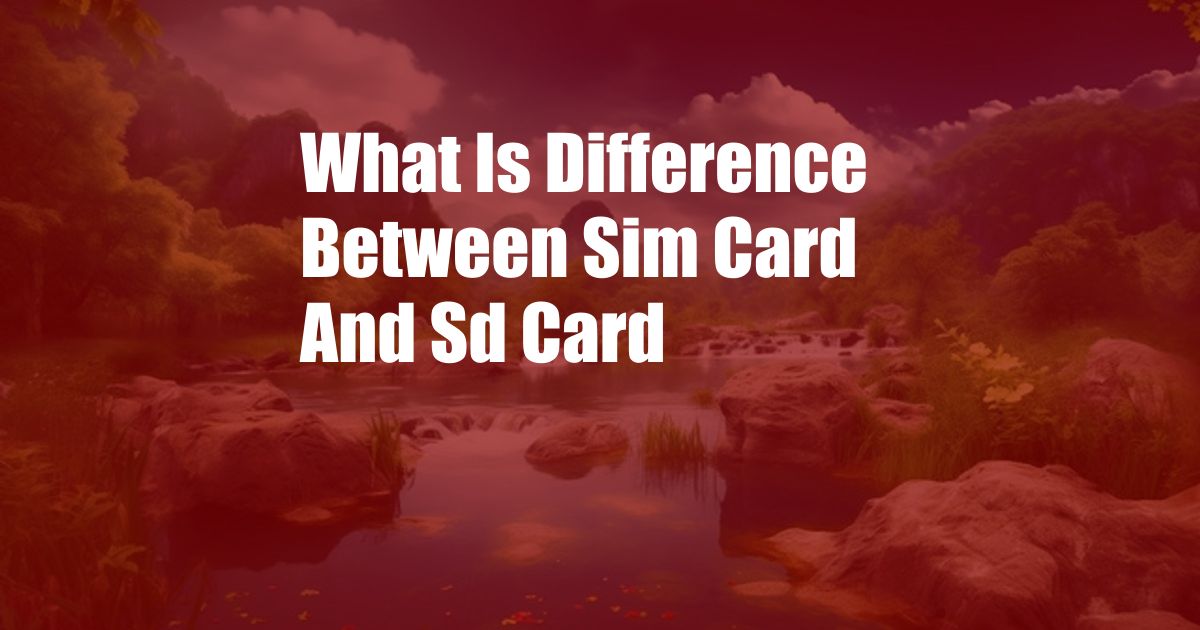
What’s the Difference Between a SIM Card and an SD Card?
When it comes to mobile devices, there are two types of cards that are often confused with each other: SIM cards and SD cards. While both cards are essential for the functioning of a mobile phone, they serve different purposes. In this article, we will delve into the key differences between SIM cards and SD cards, explaining their functions, usage, and the latest trends surrounding them.
SIM Card: The Key to Connectivity
Understanding SIM Cards
A Subscriber Identity Module (SIM) card is a small, removable card that is inserted into a mobile phone to enable cellular network connectivity. It contains a unique identifier that links the phone to a specific mobile network operator, allowing the user to make calls, send text messages, and access data services. The SIM card also stores personal information such as contacts, text messages, and call logs.
SIM cards are typically provided by mobile network operators when a new phone is purchased or when a new subscription plan is activated. They can be easily removed and swapped between compatible devices, allowing users to switch between different phones or networks without losing their data. Additionally, SIM cards can be used in IoT (Internet of Things) devices, such as smartwatches and fitness trackers, to provide cellular connectivity.
SD Card: Expanding Storage Capacity
Exploring SD Cards
A Secure Digital (SD) card is a removable storage device that is used to expand the storage capacity of a mobile phone or other electronic devices. SD cards are available in various sizes and speeds, allowing users to store large amounts of data, including photos, videos, music, and documents.
Unlike SIM cards, SD cards do not require a subscription to a mobile network operator. They can be purchased separately and inserted into a designated slot on the device. SD cards are commonly used in smartphones, tablets, digital cameras, and other portable devices that need additional storage space.
Latest Trends and Developments
As technology continues to evolve, both SIM cards and SD cards are undergoing advancements to meet the changing needs of users.
- eSIM: Embedded SIM (eSIM) technology is gaining popularity, allowing mobile devices to connect to cellular networks without the need for a physical SIM card. eSIMs are embedded directly into the device, making them more secure and convenient to use.
- 5G Connectivity: The advent of 5G networks has created a demand for SIM cards that can support faster data speeds and lower latency. New SIM cards are being developed to enable 5G connectivity, allowing users to take advantage of the latest mobile network technology.
- High-Capacity SD Cards: With the increasing popularity of high-resolution photos and videos, the demand for SD cards with larger storage capacities is growing. Manufacturers are now producing SD cards with capacities of up to 1TB and beyond, providing ample space for storing multimedia content.
Tips and Expert Advice
To ensure optimal performance and utilization of SIM cards and SD cards, consider the following tips and expert advice:
- Choose the Right Card: Select a SIM card from a reputable mobile network operator that offers reliable coverage and data speeds in your area. For SD cards, consider the capacity, speed, and compatibility with your device.
- Handle with Care: SIM cards and SD cards are delicate electronic devices. Always handle them with care to avoid damage. Avoid bending or scratching the cards, and keep them away from moisture and extreme temperatures.
- Keep Data Backed Up: The data stored on SIM cards and SD cards can be lost due to accidental deletion, device failure, or other unforeseen circumstances. Regularly back up important data to a secure cloud storage service or a local computer.
FAQs
Q: Can I use a SIM card in an SD card slot?
A: No, SIM cards and SD cards are different types of cards and cannot be used interchangeably. They have different physical shapes and functionalities.
Q: How do I know which type of SIM card my phone uses?
A: Consult your phone’s user manual or check the SIM card tray. Common SIM card sizes include standard SIM, micro-SIM, and nano-SIM.
Q: Can I use an SD card to make phone calls or send text messages?
A: No, an SD card is used solely for storage purposes. It does not have the functionality to enable cellular network connectivity or communication services.
Conclusion
Understanding the difference between SIM cards and SD cards is crucial for optimizing the performance and functionality of mobile devices. SIM cards provide cellular connectivity, while SD cards expand storage capacity. By choosing the right cards and following the tips outlined above, users can ensure seamless communication and ample storage space for their mobile needs.
If you have found this article informative and would like to learn more about SIM cards, SD cards, or other related topics, please let us know in the comments section below. Your feedback helps us create content that is relevant and engaging for our readers.